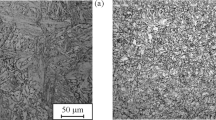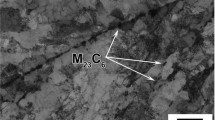Conclusions
-
1.
At temperatures below the equcohesive temperature, i.e., with transcrystalline fracture, the long-term strength of Cr−Ni and Cr−Ni−Mo steels increases continuously with increasing boron additions up to 0.005%. At temperatures above the equicohesive temperature, where fracture is intergranular, the long-term strength of the steels is highest at boron concentrations of 0.001–0.0018%.
-
2.
The following mechanisms of the increase in the long-term strength with small boron additions were established: a) small boron additions increase the strength of the grain boundaries, which is manifest at temperatures above the equicohesive temperature; b) small boron additions slow down the diffusion processes of precipitation of excess phases in the boundaries and within the grains during creep; c) additional strengthening of the grain boundaries evidently occurs at concentrations of 0.004–0.005% B due to precipitation of dispersed borides.
Similar content being viewed by others
Literature cited
M. V. Pridantsev and K. A. Lanskaya, Steels for Boilermaking [in Russian], Metallurgizdat, Moscow (1959).
D. Lavelles and F. Bloom, Iron Age, 179, No. 25 (1957).
M. P. Sidel'kovskii et al., Stal', No. 3 (1966).
M. P. Sidel'kovskii et al., in: Rare Earth Metals and Alloys [in Russian], No. 2, Kiev-Odessa (1968).
E. Simons, Boron in Steel Tooling, 14, No. 3 (1960).
M. L. Bernshtein, Steels and Alloys for Operation at High Temperatures [in Russian], Metallurgizdat, Moscow (1956).
V. I. Prosvirin et al., in: Problems of Metal Science of Austenitic Steels [in Russian], Mashgiz, Moscow (1952).
A. Mercier and I. Hochmann, Rev. Metallurgie,59, Nos. 7-8 (1962).
G. Henry et al., Rev. Metallurgie, 60, No. 12 (1963).
I. I. Kornilov, Physicochemical Basis of Heat Resistant Alloys [in Russian], Izd. AN SSSR, Moscow (1961).
V. K. Grigorovich, Heat Resistance and Phase Diagrams [in Russian], Metallurgiya, Moscow (1969).
O. A. Bannykh et al., Structure and Properties of Heat Resistant Metallic Materials [in Russian], Nauka, Moscow (1967).
Additional information
Volgograd Scientific-Research Institute of Heavy Machine Construction. Translated from Metallovedenie i Termicheskaya Obrabotka Metallov, No. 6, pp. 2–4, June, 1973.
Rights and permissions
About this article
Cite this article
Morozov, Y.A., Sidel'kovskii, M.P. & Rozenberg, V.M. Heat resistance of Cr−Ni and Cr−Ni−Mo steels with boron additions. Met Sci Heat Treat 15, 447–450 (1973). https://doi.org/10.1007/BF01153257
Issue Date:
DOI: https://doi.org/10.1007/BF01153257




